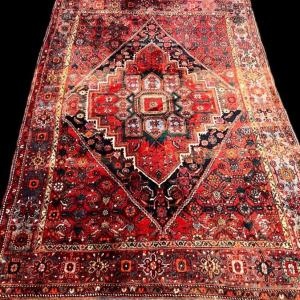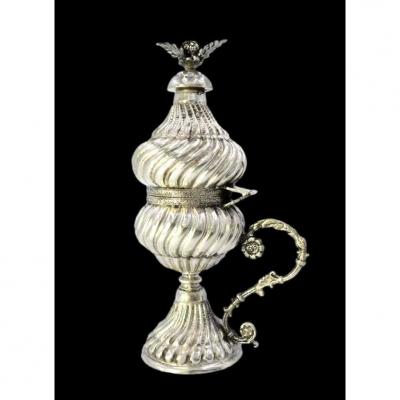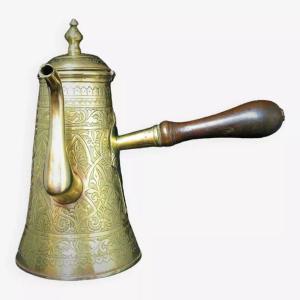In a large central medallion with pendants "a wreath of flowers like a tree of life" surrounded by four smooth mandorlas decorated with portraits of Armenian kings.
## Artaxias I, Abgar V, Ashot II, and Hayk Nahapet, descendant of Noah, who fought a giant of Babylon and gave his people the territory of Armenia. The medallions are inscribed in a decor abounding with interlacing flowers, of a high quality of engravings.
The composition of the top of the lid is treated like a carpet, large central medallion with pendants, and edges of the top worked like borders.
The outer edge is treated like a rush, smooth and hemmed.
This piece of a remarkable quality of work is part of the Kadjar period, its area of creation is Persia of the 19th century, Iran today.
# Our expertise leads us to favor Armenian work created in a Kadjar context in the 19th century.
# Artaxias or Artašēs I: (in Armenian Արտաշես Ա) is a king of Armenia who reigned from 190/189 to 159 BC.
He is traditionally considered the founder of the Artaxiad dynasty. # Abgar V Bar Ma'Nu or Abgar Oukhama: is a king of Osroene who reigns in Edessa for two periods, first from 7 BC. AD to 4 BC. AD, when he was replaced by his brother Ma'Nu IV Bar Ma'Nu.
He regains the throne of Edessa and reigns again until his death in c. Bagratids.
King of Armenia from 912 to 928 and son of Smbat Iᵉʳ the Martyr, King of Armenia.
# Haïk in Armenian: Հայկ, also called Haik, Hayk or Haig, and also nicknamed Haïk Nahapet (in Armenian: Հայկ Նահապետ) (often represented with a bow): He is the first legendary king of Armenian mythology and is therefore the patriarch and ancestor of all Armenians, and the founder of the Haikid dynasty that bears his name.
According to legend, he took 300 people with him out of Babylon, pursued by his lord, Bel. As a result, a great battle took place, during which Hayk's arrow found its target, killing Bel, and thus ushering in a new era. In one of the versions of the Armenian calendar the new era begins on this date, which would correspond to August 11, 2492 BC.
The year 2492 BC, the date of this event, was calculated in modern times.
. The harmonious and thin sides in engravings present a scene of a shepherd and his sheep, wreaths of flowers, and a scene representing two men facing each other passing a basin.
A magnificent artefact of Persian art, our highly crafted model can only become a centerpiece of a fine collection.
All in wonderful condition.
Dimensions: height: 4.5 cm, width: 8 cm, length: 15.5 cm, weight: 403 grs
FREE SHIPPING FOR FRANCE as for all of our objects!!! FR 0€ / EUR 25€ / WORLD 50€
- For all requests for information, do not hesitate to contact me on 06 13 36 09 30 or on winsteinprovence@gmail.com
You will find on our site a wide range of Persian rugs , Anatolian and Caucasian and a fine collection of ancient objects.
www.winsteinprovence.com COME AND VISIT US !!!
(texts, photo credits, Winstein, all rights reserved)

















































 Le Magazine de PROANTIC
Le Magazine de PROANTIC TRÉSORS Magazine
TRÉSORS Magazine Rivista Artiquariato
Rivista Artiquariato